
The Battle of Gettysburg was a three-day battle in the American Civil War fought between Union and Confederate forces between July 1 and July 3, 1863, in and around Gettysburg, Pennsylvania. The battle, which was won by the Union, is widely considered the Civil War's turning point, ending the Confederacy's aspirations to establish an independent nation. It was the Civil War's bloodiest battle, claiming over 50,000 combined casualties over three days.
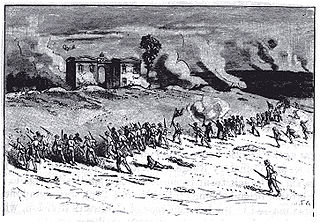
Cemetery Hill is a landform on the Gettysburg Battlefield that was the scene of fighting each day of the Battle of Gettysburg. The northernmost part of the Army of the Potomac defensive "fish-hook" line, the hill is gently sloped and provided a site for American Civil War artillery.

Culp's Hill, which is about 3⁄4 mi (1,200 m) south of the center of Gettysburg, Pennsylvania, played a prominent role in the Battle of Gettysburg. It consists of two rounded peaks, separated by a narrow saddle. Its heavily wooded higher peak is 630 ft (190 m) above sea level. The lower peak is about 100 feet shorter than its companion. The eastern slope descends to Rock Creek, about 160 feet lower in elevation, and the western slope is to a saddle with Stevens Knoll with a summit 100 ft (30 m) lower than the main Culp's Hill summit. The hill was owned in 1863 by farmer Henry Culp and was publicized as "Culp's Hill" by October 31, 1865.
The XII Corps was a corps of the Union Army during the American Civil War.

The Gettysburg campaign was a military invasion of Pennsylvania by the main Confederate army under General Robert E. Lee in summer 1863. It was the first time during the war the Confederate Army attempted a full-scale invasion of a free state. The Union won a decisive victory at Gettysburg, July 1–3, with heavy casualties on both sides. Lee managed to escape back to Virginia with most of his army. It was a turning point in the American Civil War, with Lee increasingly pushed back toward Richmond until his surrender in April 1865. The Union Army of the Potomac was commanded by Maj. Gen. Joseph Hooker and then by Maj. Gen. George G. Meade.

Freeman McGilvery was a United States Army artillery officer during the American Civil War. He gained fame at the Battle of Gettysburg for taking the initiative to piece together a line of guns that greatly contributed to the Union victory.

The first day of the Battle of Gettysburg during the American Civil War took place on July 1, 1863, and began as an engagement between isolated units of the Army of Northern Virginia under Confederate General Robert E. Lee and the Army of the Potomac under Union Maj. Gen. George G. Meade. It soon escalated into a major battle which culminated in the outnumbered and defeated Union forces retreating to the high ground south of Gettysburg, Pennsylvania.

During the second day of the Battle of Gettysburg Confederate Gen. Robert E. Lee attempted to capitalize on his first day's accomplishments. His Army of Northern Virginia launched multiple attacks on the flanks of the Union Army of the Potomac, commanded by Maj. Gen. George G. Meade. The assaults were unsuccessful, and resulted in heavy casualties for both sides.

The 7th Ohio Infantry Regiment was an infantry regiment formed in northeastern Ohio for service in the Union Army during the American Civil War. It served in the Eastern Theater in a number of campaigns and battles with the Army of Virginia and the Army of the Potomac, and was then transferred to the Western Theater, where it joined the Army of the Cumberland besieged at Chattanooga. It was noted for its holding the high ground at the center of the line at Antietam as part of Tyndale's 1st Brigade, Greene's 2nd Division of Mansfield's XII Corps. It is of the 7th regiment that a war historian wrote, "All in all, considering the number of its battles, its marches, its losses, its conduct in action, it may be safely said that not a single regiment in the United States gained more lasting honor or deserved better of its country than the Seventh Ohio Volunteer Infantry."
Archibald Livingston McDougall was an officer in the Union Army during the American Civil War who commanded the 123rd New York Volunteer Infantry early in the war and subsequently led a brigade at the Battle of Gettysburg.
Edward Duchman Muhlenberg was an American civil engineer in the railroad industry and an officer in the Union Army during the American Civil War. He commanded an artillery brigade at the Battle of Gettysburg while only a lieutenant. He played an important role in the defense of Culp's Hill against attacking Confederates.

Andrew Cowan served as a Union artillerist in the American Civil War. He distinguished himself at the Battle of Gettysburg and the Battle of Sayler's Creek. Subsequently, he "amassed a fortune in the leather industry and used that wealth in a variety of philanthropic activities. In addition, he was a prominent force in healing the wounds between the North and South and bringing peace to a fractured nation."
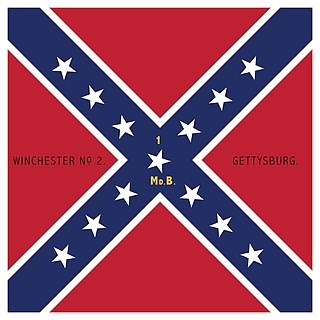
The 2nd Maryland Infantry Regiment was a Confederate infantry regiment made up of volunteers from Maryland who, despite their home state remaining loyal to the Union during the American Civil War, chose instead to fight for the Confederacy. The regiment was largely made up of volunteers from the 1st Maryland Infantry, CSA, which was disbanded in August 1862, its initial term of duty having expired. They saw action at many of the fiercest battles of the Civil War, taking part in the brutal fighting at Culp's Hill at the Battle of Gettysburg. The unit suffered such severe casualties during the war that, by the time of General Robert E. Lee's surrender at Appomattox Court House on April 9, 1865, only around forty men remained.
Charles E. Winegar commanded an artillery battery in the Union service during the American Civil War.
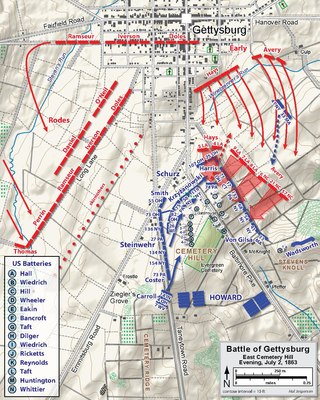
The battle of East Cemetery Hill during the American Civil War was a military engagement on the second day of the Battle of Gettysburg, in which an attack of the Confederacy's Louisiana Tigers Brigade and a brigade led by Colonel Robert Hoke was repelled by the forces of Colonel Andrew L. Harris and Colonel Leopold von Gilsa of the XI Corps, plus reinforcements. The site is on Cemetery Hill's east-northeast slope, east of the summit of the Baltimore Pike.

The 45th New York Infantry Regiment, also known as the 5th German Rifles, was an infantry regiment that served in the Union Army during the American Civil War. It was composed almost entirely of German immigrants. Formed approximately five months after the start of hostilities, the unit's service spanned almost the entirety of the war, and it saw action in several of the war's noteworthy battles, in both the Eastern and Western Theaters.

Independent Battery F, Pennsylvania Light Artillery, also known as the "Pittsburg Battery", was an artillery battery that served in the Union Army during the American Civil War. Organized in December 1861, the unit first served in the Shenandoah Valley. Battery F fought at Hancock, Winchester, Sulphur Springs, Second Bull Run, Chantilly, and Antietam in 1862. The following year the unit fought at Chancellorsville, Gettysburg, the Bristoe Campaign, and Mine Run. In 1864–1865, Battery F fought at Morton's Ford and served in the garrisons of Washington, D.C., and Harper's Ferry, West Virginia before being mustered out in June 1865. One enlisted man from the battery won the Medal of Honor for heroic action at Gettysburg.
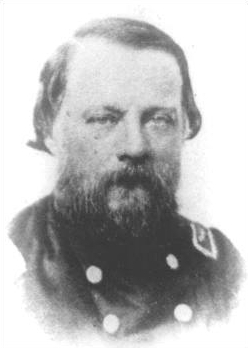
The 1st Louisiana Infantry Regiment was a unit of volunteers recruited in Louisiana that fought in the Confederate States Army during the American Civil War. Formed in April 1861, the regiment was sent to fight in the Eastern Theater of the American Civil War. Joining a brigade of Louisiana regiments, it fought at Malvern Hill, Second Bull Run, Antietam, and Fredericksburg in 1862, at Chancellorsville, Second Winchester, Gettysburg, and Mine Run in 1863, and at the Wilderness, Spotsylvania, Monocacy, Third Winchester, Fisher's Hill, Cedar Creek, and Petersburg in 1864, and at Appomattox in 1865. At Appomattox, the regiment was only a shadow of its former self.
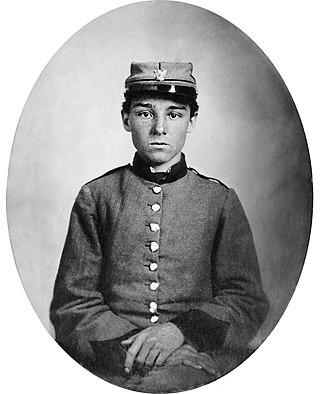
The 2nd Louisiana Infantry Regiment was a unit of volunteers recruited in Louisiana that fought in the Confederate States Army during the American Civil War. Formed in May 1861, the regiment was sent to fight in the Eastern Theater of the American Civil War. Its first action took place during the Siege of Yorktown. The regiment suffered very heavy losses at Malvern Hill. After joining an all-Louisiana brigade, it fought at Cedar Mountain, Second Bull Run, Antietam, and Fredericksburg in 1862, at Chancellorsville, Second Winchester, Gettysburg, and Mine Run in 1863, and at the Wilderness, Spotsylvania, Cold Harbor, Monocacy, Third Winchester, Fisher's Hill, Cedar Creek, and Petersburg in 1864, and at Appomattox in 1865. The regiment lost over 100 men at both Second Bull Run and Chancellorsville. A company-sized remnant surrendered at Appomattox.

The Louisiana Guard Battery was an artillery unit recruited from volunteers in Louisiana that fought in the Confederate States Army during the American Civil War. Formed from an infantry company sent to fight in the Eastern Theater of the American Civil War, it was converted to an artillery company in July 1861. The battery fought at Cedar Mountain, Second Bull Run, Antietam, and Fredericksburg in 1862, and at Chancellorsville, Second Winchester, and Gettysburg in 1863. Most of the soldiers and all of the battery's guns were captured at Rappahannock Station on 7 November 1863. The surviving gunners manned heavy artillery pieces in the defenses of Richmond, Virginia, and the battery's remnant surrendered at Appomattox.
















